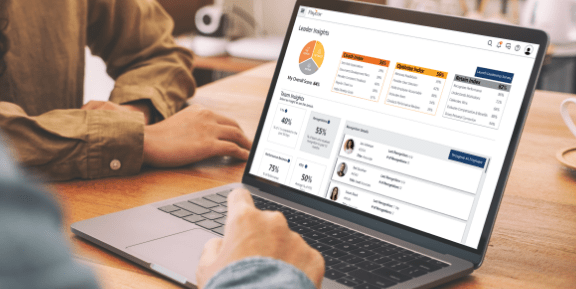According to the Bureau of Labor Statistics, workplace benefits are available to 72% of American employees, which equates to a lot of work for benefits administrators during open enrollment periods (BLS). However, with the right information, employee benefits plan enrollment doesn’t have to be a headache. With a better understanding of the process (and the right partners), you can make the process less stressful and more efficient.
Open Enrollment 101: The Basics
Benefits are an important part of any HR strategy. They affect recruiting, retention, employee loyalty, and more. But keep in mind your benefits package only helps the employees who actually use it.
Open enrollment is your annual opportunity to boost employee engagement, productivity, and well-being. During this time, it’s important for HR to support employees through benefits plan enrollment. You can do that by communicating clearly, keeping to a set schedule, and expecting the unexpected. For example, you could set aside time to answer your employees’ questions and follow up with your insurance carrier. Partnering with a broker can also help you streamline this process since you’ll have more access to an expert in the field.
Most importantly, HR should plan ahead. Reading this article is a great place to start.
What is Open Enrollment?
Open enrollment is the time during the year, generally two to four weeks long, when companies allow their employees to make changes or additions to their elected fringe benefits such as health insurance, unemployment benefits, or retirement plans. Employee benefits plan enrollment goes well when there’s clear communication, a strict schedule, and insurance providers who can support HR through the process. Without the right tools, though, it can be a major headache.
Open Enrollment vs. Annual Enrollment
The terms are often used interchangeably, but there’s a slight difference:
Open enrollment generally refers to the specific window when employees can enroll or make changes.
Annual enrollment often describes the broader process employers manage each year, including planning, communications, and compliance.
How Does Open Enrollment Work?
The employer sets the enrollment window, which typically lasts a few weeks. During that time, employees:
- Review their current benefits and costs.
- Compare available plan options for the upcoming year.
- Select, change, or waive coverage.
- Confirm dependents are enrolled correctly.
Is Open Enrollment Required by Law?
Yes. Under the Affordable Care Act (ACA), most employers with 50 or more full-time equivalent employees (Applicable Large Employers) must offer health coverage and provide an annual open enrollment period so eligible employees can accept or decline coverage.
How Should You Prepare for Employee Benefits Plan Enrollment?
Getting organized ahead of time will help streamline your benefits administration. HR should:
- Get renewal numbers and rates from your carriers for the coming plan year.
- Analyze costs and decide whether you’ll switch carriers well in advance.
- Communicate with employees about any changes this year (especially pertaining to the Affordable Care Act) and prepare them for the open enrollment process.
It’s impossible to make smart decisions about benefits without data. Paycor’s HR software allows employers to access status reports to see the progress of the current enrollment period, compare coverage costs from different years, and gauge how employee election trends change from year to year.
How Long Is Open Enrollment for Insurance?
Most employers set their open enrollment period for two to four weeks, often in the fall, for coverage beginning January 1.
How Long Do New Hires Have to Enroll in Benefits?
New employees typically have 30 days from their hire date (or eligibility date) to enroll in health benefits. After that, they must wait until the next enrollment period unless they experience a qualifying life event.
What Should You Do During an Open Enrollment Period?
- Be explicit with your employees on when the enrollment deadline is.
- Share details about the current plan so eligible employees can use them as a guide to make decisions as to what they will need in the new plan year.
- Collect all the relevant information from your employees.
- Update payroll with the new deductions.
- Notify your carriers of changes and new enrollments.
How Can You Overcome Common Open Enrollment Challenges?
Many HR departments face serious administrative problems during employee benefits plan enrollment. This is often due to a few common mistakes. Here’s how to avoid them:
- Go paperless. Today, most employers build their plans online, and their employees sign in to make their elections at home, in the office, or anywhere. Paycor’s Benefits Advisor enables employees to view benefit plan summaries and other documents, receive updates on uncompleted enrollment tasks, and review how their elections will affect their compensation.
- Eliminate unnecessary data entry. Once employees have made their elections, HR has to input all the updated information into their payroll system, which poses the risk of human error. With Paycor’s single system of record there’s no double entry, saving time and greatly reducing the chance of error.
- Enjoy seamless connectivity to carriers. After employee elections are updated in your system, you still have to notify your insurers. Paycor pushes enrollments directly to carriers, so there’s no need to update this information in multiple places.
Is One Open Enrollment Conversation Good Enough?
According to a survey, 86% of employees are confused about benefits (Business Solver). Employers can address this confusion by communicating about benefits throughout the year, not just during open enrollment season. The subject matter is complicated and outside many employees’ areas of expertise.
Think of this as a training module or even an internal marketing campaign. A robust communication strategy can empower your team to make the best possible choices about benefits. Communicate with employees through as many channels as possible, such as:
- Company intranet
- Newsletters
- Posters and banners
- Paycheck inserts
- Webinars
If you’re sending out information electronically, it’s a good idea to have current personal email addresses on file so that employees, especially remote and frontline workers, can access the details of the health insurance plan at home.
Employer Open Enrollment Tips & Best Practices
Keep in mind that open enrollment doesn’t have to be a scramble every year. With some strategic planning and the right approach, you can transform the process from a stressful headache into a smooth, well-organized experience for everyone involved. Here’s how:
- Start early: Build your timeline at least 3–4 months in advance.
- Keep messaging simple: Use plain language and visuals to explain complex benefits.
- Use technology: Online open enrollment software simplifies elections and reduces errors.
- Train managers: Equip managers to answer common questions.
- Monitor participation: Track progress and follow up with employees who haven’t completed enrollment.
Open Enrollment Length, Timing & Frequency
The timing and duration of open enrollment can affect employee participation, compliance, and overall satisfaction. Here’s what you need to know about when most companies hold enrollment and how to set the right schedule for your workforce.
When Do Most Companies Have Enrollment?
The open enrollment period differs for every company, but it typically starts 1–2 months prior to coverage beginning. If a company is on a calendar year plan, benefits coverage often kicks off January 1, so enrollment would start November 1.
Keep in mind that some states have their own enrollment platforms for health insurance, so be sure to review your state requirements.
When Does Open Enrollment End?
For calendar-year plans beginning January 1, open enrollment usually ends in mid-to-late November or early December. Exact dates vary by employer.
How Long Does Open Enrollment Have to Be?
The ACA requires that employers give employees a minimum of 14 days to make benefit elections. Many organizations choose a 2–4-week period to give employees enough time.
Do You Have to Do Open Enrollment for Employees Every Year?
Yes. If they have 50 or more full-time equivalent employees (Applicable Large Employers), employers must offer open enrollment annually, even if benefits haven’t changed. This ensures employees have the chance to review or update coverage.
Employee Open Enrollment Benefit Changes & Exceptions
Once open enrollment closes, the window shuts pretty firmly for most employees. Here are the key exceptions and rules you need to know when employees ask about making changes after the deadline has passed.
Can Employees Enroll in Benefits After Open Enrollment?
Not unless they have a qualifying event. Otherwise, they must wait until the next open enrollment period.
Can Employees Change their Benefits Afterwards?
Generally, no unless they experience a qualifying life event such as marriage, divorce, birth/adoption, or loss of other coverage.
What Am I Legally Required to Do if an Employee Misses Open Enrollment?
If an employee misses the deadline and does not have a qualifying event, employers are not required to allow them to enroll until the next open enrollment. However, HR should clearly communicate deadlines and offer reminders to help employees avoid missing out.
Benefits Open Enrollment Strategies
Open enrollment is more than just a compliance requirement; it’s a chance to engage employees and highlight the value of your benefits package. A few focused strategies can make the process smoother and more effective:
- Start with employee feedback: Survey employees after each enrollment period to understand which benefits they value most and where they need more support.
- Communicate clearly and often: Share reminders early, highlight what’s new or changing, and use multiple channels so employees don’t miss important updates.
- Provide decision-making tools: Simple plan comparisons, premium calculators, and FAQs help employees make confident choices.
- Promote the full package: Remind employees about less-used offerings such as wellness benefits, voluntary coverage, or retirement contributions.
- Use technology: Online enrollment platforms reduce errors, streamline forms, and give HR visibility into participation.
With the right preparation and communication, you can transform open enrollment from a stressful season into a positive employee experience.
Required Forms for Employee Benefits Open Enrollment
Open enrollment involves more paperwork than just picking a health plan. Here are the forms your employees will need to complete to get their benefits locked in properly.
What Forms Are Necessary to Complete Open Enrollment?
Employees typically need to complete:
- Health insurance enrollment forms (medical, dental, vision)
- Beneficiary designation forms for life and disability coverage
- Dependent verification forms if adding family members
What Is the Purpose of a Health & Dental Form?
These forms capture employee elections for healthcare and dental plans, ensuring the correct coverage is applied and payroll deductions are set up accurately.
How Paycor Helps with Open Enrollment
Managing open enrollment can be complex, especially with multiple plan options and compliance deadlines. Paycor makes open enrollment easier by:
- Offering a user-friendly online benefits platform where employees can compare and select plans.
- Offering an ACA reporting software that automates ACA compliance reporting and integrates benefits with ACA payrolldata.
- Providing HR teams with real-time insights into enrollment progress.
- Reducing errors with built-in eligibility checks and required fields.
Use Paycor for Your Open Enrollment Benefits
Open enrollment doesn’t have to be stressful. With the right tools, you can improve participation, ensure compliance, and give employees the information they need to make confident decisions. Paycor’s benefits adminisration solutions help support HR through every step of employee benefits plan enrollment.
Take a quick tour of Paycor today and see how our platform streamlines open enrollment, simplifies Affordable Care Act compliance reporting, and empowers HR leaders to focus your people. You can also download our Benefits Administration: A Guide for HR Leaders for practical tips on how to design a benefits package or our open enrollment checklist to help you simplify the process.









